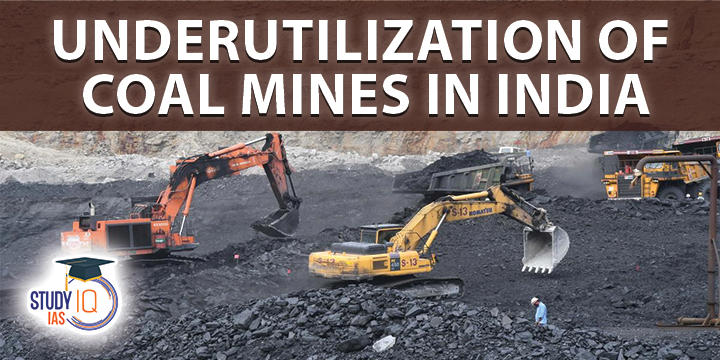Table of Contents
Coal Mines Industry in India
India is the second largest producer and consumer of coal after China. Jharkhand, Odisha, and Chhattisgarh accounted for almost 70% of the total known Coal Reserves in India.
Coal Mines in India: India is also the second largest importer of coal.
Types of Coal Mines in India
There are many Types of Coal Mines in India
-
- Gondwana deposits: Gondwana deposits of coal are present in eastern Indian states of Jharkhand, Odisha, Chhattisgarh, West Bengal etc.
- Tertiary deposits: Tertiary deposits are present in the north-eastern states of Assam, Meghalaya, Nagaland and Arunachal Pradesh.
- Lignite: Lignite deposits are present majorly in the states of Tamil Nadu, Rajasthan and Gujarat.
- Usage of coal:
- Electricity sector: It is the largest consumer of coal in India. It accounts for about 64.07% of the total coal consumed in the country.
- Iron & steel industry: Iron and steel industry uses coal for coking. Since India does not have high quality coal reserves, majority of it is imported.
- Other usage: Coal is also used in industries such as cement, fertilizers, chemicals, paper and textiles industries.
- Effects of coal on the country:
- Health burden: Harmful emission from coal can cause asthma and breathing difficulties, brain damage, heart problems, cancer, neurological disorders, and premature death.
- Parallel economy: Coal industry has been indirectly controlled by mafia, which illegally extracts and sells coal with/without the knowledge of the authorities. It has given rise to a parallel economy in the region.
- Global warming: Coal is responsible for over 0.3C of the 1C increase in global average temperatures. It is the single largest source of global temperature rise.
- Pollution: Coal is responsible for air pollution through emissions and dust. Coal also causes pollution of water sources.
Effects of New Coal Mines in India
- Tribal population: Developing coal mines threaten to displace at least 165 villages and affect 87,630 families. Majority of these families live in areas where the predominant population is tribal communities.
- Loss of valuable land: Coal mine development will threaten destruction of 22,686 hectares of agricultural land and 19,297 hectares of forest land.
- Water consumption: Coal mines will consume at least 168,041 kilolitres of water per day, equivalent to the daily water needs of over one million people.
- About 37% of plants will be located in high-risk water zones, while 54% is planned in zones with extreme water-risk.
- Ecology: New projects raise new ecological issues for wildlife of the area, especially for elephants and the tiger.
- Net zero targets: Developing more coal mines will increase stranded assets and delay a clean energy future. This will be detrimental to India’s net zero aim by 2070.
Coal Mines in India Report by Global Energy Monitor (GEM)
- Study: The study was carried out by surveying annual reports of Coal India Limited (CIL), the largest coal producer in the world, and its subsidiaries.
- As per the report, CIL has not listed capacity constraints as among the reasons it cannot reach production targets.
- Rather, CIL has blamed the competition from renewables, infrastructure impasses, and land-use concerns for hindering output.
- Existing Utilization of Coal Mines:
- On average, India’s coal mines utilize only two-thirds of their capacity with some large ones using only 1%.
- Jharkhand and Odisha alone account for 40 per cent of unused mine capacity in the country.
- Coal India (CIL) and Singareni have a large share of underutilization. The highest underutilization rate is at the mines run by CIL subsidiaries Central Coalfields Limited (CCL) and Eastern Coalfields Limited.
- In mines such as Talabira, Talaipalli and Pachhwara, the utilization rate is less than 1%.
Why does New Coal Mines in India Need
- Mines under development in India are unnecessary to meet power-sector demand. The shortage that occurred last year was due to factors such as monsoonal rains, pandemic related supply chain constraints and the Ukraine War.
- Developing new mines would not resolve the mining sector’s chronic issues, including financial insolvency and low labor productivity. New mines are likely to be affected by the same inefficiencies.
- India’s existing capacity is still enough to sustain peak output. Efficiency of existing mines needs to be improved.
Coal Mines in India News
- The report was brought out by Global Energy Monitor (GEM), a firm that tracks utilization of the fuel-source internationally.
- The report also adds that 99 of India’s coal mine projects under development are not necessary and opening new coal mines will not contribute to easing short-term supply-crunches.
- As per the report, there is plenty of coal supply to meet a short-term supply crunch. But the continued shortfall is a stark reminder that up to 70% of the India’s active mines operate at a financial loss and low labor productivity jeopardizes output.
- Reasons for new coal projects: Last year, India faced severe coal crises with more than 100 thermal power plants witnessing coal stocks fall below the critical mark of 25% of the required stock.
- This event led to power shortages in several States, including Andhra Pradesh, Jharkhand, Uttarakhand and Madhya Pradesh.



 Current Affairs 25th April 2024 for UPSC...
Current Affairs 25th April 2024 for UPSC...
 Editorial of the day (25th Apr): UK's Rw...
Editorial of the day (25th Apr): UK's Rw...
 Telangana Judicial Recruitment Notificat...
Telangana Judicial Recruitment Notificat...

















